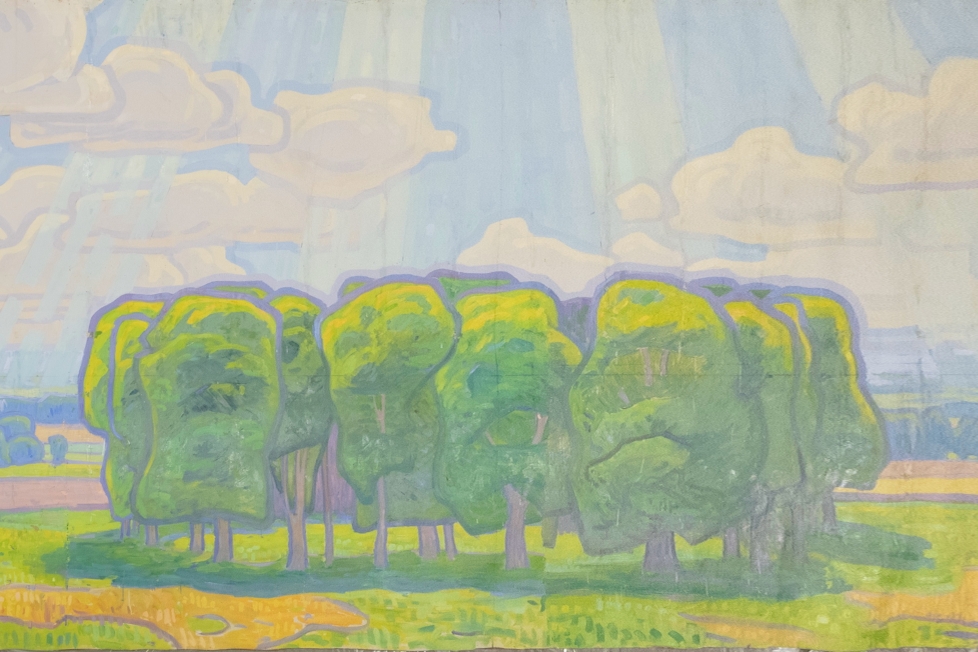Though Hilma af Klint died in 1944, she has never been in higher esteem. The paintings of the Swede, who claimed to literally paint as if possessed, have toured some of Europe’s finest showcases for art within a bit more than a year – from Moderna Museet to the Venice Biennial to Hamburger Bahnhof and recently Louisiana. She has been relaunched as a “Pioneer of Abstraction”. She is said to have been ahead of the art of her time. But that is only so, of course, in case her work is really art.

On the occasion of the installment of Hilma af Klint: A Pioneer of Abstraction at Louisiana, the museum by the seaside north of Copenhagen had invited art historian Thierry de Duve to give a talk. Though he is especially known for his seminal books on Marcel Duchamp such as Pictorial Nominalism and Kant after Duchamp, this time around he set out to revisit the history of Modernist painting which Hilma af Klint is belatedly entering.
Before the Belgian art historian presented his sweeping take on the changes in the art world in 19th century France, Kunstkritikk got the chance to interview him. Hilma af Klint was but a starting point for a talk about what art is, what non-art is and our current “art-in-general system”.
The following is an only lightly edited transcript of a conversation that jumps from Manet, Kant and Plato to soccer fans and embryo eaters. But also about currently popular ideas in favour of a theoretical shift of focus from experiencing art to making art – and why such a shift from aesthetics to poetics is misleading.
You’ve written a lot about what art is and when talking about Hilma af Klint this question constantly comes up. What is your immediate reaction to this topic?
Oh, there is no doubt that it is art… I was a little skeptical before I saw the show because of all the spiritual blah-blah around the work. But then I discovered that Hilma af Klint was a very good painter. There is no doubt that her work is art on any account. It’s painting. She was trained as an artist. You cannot discount the work simply because the motivation is a spiritual one more than an artistic one, if that’s the case, which I doubt. Those motivations very often go together. The beauty of a Bellini painting has everything to do with him being a true believer. That he paints the Virgin so beautifully has everything to do with his belief.
Your most recent writing is your series ”The Invention of Non-art” in Artforum. You revisit France in the 19th century. You deal with the collapse of le système des beaux-arts and a new aesthetic regime characterized by what you call ‘art in general’. But allow me to go back one step. What do you understand by the “non-art” mentioned in the title? What’s the definition?
What I call the invention of non-art is, I believe, very important in order to understand how we came from the beaux-arts system to the art-in-general system via the negation of art. In this interview I must simplify. The context is the 19th century Salon, where the jury had no choice besides accepting or refusing a work. Then, if a painting is refused because it is judged to be so bad or so scandalous that it is not identified as a painting worthy of the name, then it is deemed “not art,” because it is obviously not a piece of music or a sculpture or a poem either. In the beaux-arts system, in order for an object to be art, it has to be one of these things. So Manet’s Déjeuner sur l’herbe was refused – with, I should add, a certain amount of denial on the part of the jury. As you imagine, the jury knew very well that it was a painting – a painting that actually redefined what a painting was supposed to be. They just couldn’t stand it. With the Déjeuner sur l’herbe’s rejection from the Salon – it was at the famous Salon des Refusés – the painting fell into a limbo of sorts. It was art denied in its art quality. That is what non-art is.

It does not fall into a category that already exists.
Exactly. A new category is inadvertently created, which is a mixed bag, you might say. In that bag there are objects that are not art, like this glass here, this spoon, this table, this tree, the sea, nature, all sorts of things. And then there are a few crucial objects in that mixed bag that are denied in their art’s quality by way of an almost Freudian denial – like, “I don’t want to hear about this.” So if you put into the same bag Manet’s Déjeuner sur l’herbe and this table, for example, you get a very strange category that is not comprised only of artworks and not only of not-artworks either. Duchamp’s genius is to have pulled out of that bag a ready-made object, like the urinal, which nobody claimed was art before him.
So it is in le système des beaux-arts that non-art is invented. But then, in the new aesthetic regime – the regime that follows and you call art in general – there is no non-art or what?
Well, to start from the beginning: We live in a world where anything can be art. Anything. Even shit, right?
Manzoni put his excrements into a can. So there is no aesthetic limit to what art can be. Then the question is: Since when is that? If you look back, say, a century and a half ago, in order for something to be art, it had to be either a painting, or a sculpture, or a piece of music, or a poem, and so on. There were categories like that. Today you can be an artist without being a painter or a sculptor or even a new media or a video artist. Young artists today don’t define themselves via the medium they are using. Very often they say: “Right now, I’m involved in a project with video, but normally I do drawing or conceptual art.” So the question that interested me was, when did we pass from one system to the other, and what are the implications for aesthetic theory. I think that Duchamp was the messenger of that passage. He has brought us the news that we have left the old fine arts system – le système des beaux-arts – and that we are now in what I call the art-in-general system. The news took the form of Fountain, the famous urinal that he did in 1917. So you might say that he posted the news in 1917, but it arrived only in the 1960s. That is when, all of a sudden, the whole art world began to look at Duchamp as a source of inspiration, of influence, but mainly of authorization. It was as if Duchamp had given us permission to do art with everything and anything – to the extent that some people think that Duchamp has changed the art world all by himself. I don’t believe that: a single man cannot do so much unless he is Stalin or Hitler or Napoleon [giggling]. But artists don’t have that kind of power. It is more reasonable to look at Duchamp as being merely the messenger of the news, but not the author of the news.

Well, then we get to another one of my questions. In Les transformateurs about Duchamp, Jean-Francois Lyotard says a very banal thing: “Each time you comment on him – Marcel Duchamp – you raise him one notch up in the hierarchy of cultural powers and you lose him.”
Oh, that’s interesting. I didn’t remember that quote. Very nice.
Yes. And then I was thinking: In your new articles, you – rightly so – make fun of the hagiography surrounding Marcel Duchamp in the 1960s. At the same time you have also written a lot about Duchamp and you keep invoking him. So do you sometimes have the feeling that Duchamp becomes your invention just like Duchamp said that “it’s the viewer who makes the art work”?
No, I don’t think so. I do sometimes speak of “my Duchamp” because Lyotard has his Duchamp and Arturo Schwarz has his Duchamp and so on. And that’s fine. But I would secretly hope that “my Duchamp” is everybody’s Duchamp [both sides of the table laughing out loud]… Now you laugh, but I want to argue that. I mean, if you interpret Duchamp through alchemy like Schwarz and Calvesi, you do not get very far in terms of Duchamp’s place in art history. But if you interpret him as heralding a sea change in the art world, you do get very far. It is a much more fruitful hypothesis, I believe, so I defend my theory [giggles].
Yes, so, in general, one might say that here you have Duchamp, but we also got “the creative class” of Montmartre, Les Arts Incohérents, who did a lot of what Duchamp did later. And then you have Manet, but before Manet we also had Gustave Courbet. So I’m thinking that maybe you could also get very far in art history without Manet and Duchamp. Or could you? Wouldn’t these changes have taken place more or less without them?
I think that this is irrelevant. I mean, you cannot ask a historian what would have happened if history had been different. History is what we are dealing with. I’m also a bit of a philosopher, but I am very careful not to invent facts. Historians deal with facts as they are. For example, I focus on the fact that Marcel Duchamp never put a readymade in a museum. He did not do it. Other people did it.
OK. So there is another very interesting observation in one of your Artforum articles. You write: “Society bestows honours on certain human activities and not on others, and there is not one society on earth (so far) that does not salute art and artists with marks of honour. These can be anything from religious worship to hero glorification to media glamorization” and so on. So no matter whether art is good or not, it is always better, in the sense, more noble than that which is not art. Is that the point you are making? Is that what you are saying?
Values such as the honorific status of art are social values. They depend on what group you are talking to. For example, I am notoriously not interested in sports. I mean, I like to practice some sports, but I’m not interested in what soccer team has won what championship. But my grandfather was absolutely fanatic about soccer. For me, art is a value, and soccer was one for my grandfather. When I say that society bestows honorific status on art, I’m looking at society as an anthropologist from outside. I just notice that every society I know – or that I know a little bit about – has celebrated artists. In Africa, the sculptor is an important person in the village. The poet, whether it is in India, in Greece, in China or in Japan, is a major figure – or was, because poetry perhaps no longer enjoys the status of the voice of the people that it still enjoyed in the 19th century. Some societies celebrate their artists as semi-gods. In New Zealand or Japan, if you are a famous artist you are considered a “national treasure,” so you’re a property of the nation, sort of. But if you are a famous artist in America, you become part of a celebrity culture where Jeff Koons is almost – but not quite – as well-known as a movie star.

And then at the end of the whole series you say that “the theoretical lesson of Duchamp has quasi-ethical implications.” And I was thinking about what ethics you are invoking – how aesthetic theory has ethical consequences…You indicate that there are some cultural, social or ethical consequences that have not been drawn from Marcel Duchamp’s lesson…
Let’s put it this way: You announced that you had a few questions on Kant, and I think that you are getting there. There is a difference in Kant between “this is beautiful” and “this is pleasant or agreeable”. “This is pleasant” means “this gives me pleasure and I don’t care about the rest of the world”. “This is beautiful” means “this is beautiful for me and should be beautiful for you and should also be beautiful for everyone else.” The judgment “This is beautiful” claims universality. My “Kant after Duchamp” reading of Kant’s Critique of Judgment is that the sentence “this is art” has exactly the same properties. “This is art” also claims that this should be art for everyone. So that universality, or rather the claim to universality – because it is of course no more than a claim, though according to Kant a legitimate claim – that claim to universality opens the door to ethics. You wouldn’t claim that kind of universality for art if you thought that art was no more than decoration or simple enjoyment. Now Kant says that the beautiful is the symbol of the morally good. The “Kant after Duchamp” version of that is, to take a shortcut: Art is the symbol of the politically good.
So are we on our way back in history – all the way to Greece and maybe even Plato?
No, why do you ask that?
Because if the beautiful is the good is the right…. But we don’t have to get into that…that was just my association…
Well, you see, maybe that’s an interesting question, because in Plato there is a hierarchy of these values. You have the truth on top. Then the good is like a copy of the truth. And then the beautiful is like a copy of a copy of the truth. This is why Plato distrusts artists, because they are only looking at shadows – shadows of shadows of the truth. But in Kant the good, the beautiful and the truth are separated. They are three different areas of human experience. Yet they communicate, and the beautiful is what makes the true communicate with the good. I think it is not by chance that this trilogy has preoccupied philosophers since Plato. You can follow it all the way through the history of philosophy – whether it is in Aristotle, whether it is in Saint Augustine…. With Kant they finally get their proper articulation.
But it seems like today people are very afraid of mixing aesthetics and ethics even though they constantly do it…
But I am also afraid of mixing them. I don’t want to mix them. What I say is that there is a communication door that opens aesthetics onto ethics. If it was not the case, there would be no difference between art and culture, and I think there is a difference between art and culture.
And what do you mean by “culture”?

Everything around us is part of our culture. That boat is part of our culture [gestures out the window towards the seaside]. I know that some people don’t make the distinction between art and culture: the advocates of visual culture vs. art and aesthetics, for example. But I make that distinction, and I think it is an important and precious distinction.
But I would say: Couldn’t it also be the lesson of Duchamp that you can no longer tell art and culture from each other given that….
No, that is not at all the lesson I draw from Duchamp.
I know. That would be my Duchamp.
Would it? Really? Well, then you have to defend it.
[laughing] Well… I don’t know: If you’re not a sociologist or “institutionalist”, who claims that the institution or art world decide what’s art, how can you tell the difference between art and culture or maybe an artwork and a cultural product? Because I guess that only depends on the context, right?
No. It depends on your judgment.
Oh…of course. Interesting.
You may disagree with me on individual artworks, and you may say “that is not art”, where I say “that is art”, or vice versa. So your notion and my notion of what is art may be different, but we both make the distinction between an artwork and a cultural product. If you don’t make that distinction, then you’re on a different planet than I.
So that means that it is the viewer that bestows art status on the art object.
Yeah, you may say that. I prefer to say that the viewer recognizes the quality of the art object.
So this is actually some of what I wanted to ask you about concerning Kant. He is concerned with the viewer or the public of the aesthetic experience – an experience of art, but it can also be of nature. And today, when we have great difficulties circumscribing art, I cannot help imagining that Kant is actually more relevant than ever, because his idea was that you can have a similar experience in front of nature that you have in front of an artwork.

That’s a very, very important question, because pure Kantian aesthetics is valid only for nature. “This is beautiful” can be a purely aesthetic judgment only in front of nature. Art forms obey conventions and conventions rely on concepts. Therefore aesthetic judgments about art cannot be pure. In Kant. But we no longer live in the art world that Kant knew. We no longer live in the beaux-arts system, we live in a system where anything can be art. All conventions have exploded, and so, art is for us no more a concept than natural beauty was for Kant. Everything that Kant said about beautiful nature is now true about art. There are complex historical reasons for that, which I am not going into.
No, of course not.
But there are historical reasons.
Ok, so one last question. Recently, theorists have started talking about the relevance of poetics as opposed to aesthetics, because aesthetics is based on our reception of art whereas poetics is the theory of the production…
…the making…
…of art. For instance, Boris Groys says that now we have to shift from aesthetics to poetics because aesthetics doesn’t teach us what we need to know about art.
From the Kant-after-Duchamp-point of view, there is no fundamental difference between aesthetics and poetics. If you take the readymade as a singular artwork that has forced us theorists to change our theory of art – I’m not the only one, there are many philosophers, aestheticians, institutional theorists of art, etc., who have come up with a new theory because of Duchamp’s readymade – the first thing you realize is that, vis-à-vis a readymade, there is in principle no difference between the artist and the viewer. Neither has made the object. The artist is just a little faster. The artist asks the viewer to confirm – or not confirm – that “This is art”. So you might say that the making, in a Duchamp readymade, is so compressed that it gets reduced to the last aesthetic judgment, say, the judgment of a painter who declares that the painting is finished… The painter takes a blank canvas and starts putting colours on the canvas and at one point stops, either because he judges that the work is finished or – and this is very often the case – because he fears that another brushstroke may ruin the painting. Now the interesting thing is that the history of painting in modernity – from Manet to the present day – has shown that the moment the canvas is declared finished gets closer and closer to the moment when the canvas got started. So in 1962, Clement Greenberg was able to say: “A stretched and tacked-up canvas already exists as a picture – though not necessarily as a successful one.” Isn’t that amazing?
Yes, I remember that…
Many artists have done almost blank canvases, but to my knowledge none has done the blank canvas per se. But imagine: you go to the art supplies store and you buy a ready-made canvas, and you hang it on the wall of the gallery and that’s it. You would have a readymade, a “painterly” readymade, as it were. So the readymade – and this is my point – makes no difference between making and judging, so that aesthetics and poetics are one and the same thing. Shall we stop here, before another brushstroke might ruin the interview? [laughing]Yeah, I think… well, one practical question.
Now, when you leave this interview you go out and visit the museum. But your way of thinking about art is very different from most of the public out there, I would say.
I don’t know about that… What makes you so sure?
I think that people do not think that they bestow art status on the art object.
That’s right. It’s also why I prefer to say that the viewer recognizes the quality of the art object. But you see, there are borderline cases – not many – where bestowing art status on the object is the same as recognizing its quality, Duchamp’s Fountain being of course exemplary. Now Fountain was a borderline case in 1917 and today is no longer one. In the posterity of Duchamp, most of the time the object is already art. The gallery or the museum that presents it asks you whether it’s good art or bad art. The only borderline cases left, it seems to me, have to do with morals. Some artists – and they are not the best – realizing that there are no aesthetic boundaries to art in the post-Duchamp art world, are set to titillating moral boundaries instead. A couple of years ago, there was a rumour that a Chinese artist whose name I forgot was eating human embryos as a performance. I think it was a sham, but if it is true then I put an ethical boundary and I say “this is not art”. Not for aesthetic reasons – for moral reasons. These things are case by case appreciations, you know.
Ok, excellent, maybe that’s it. Thank you so much.










Funny that de Duve is now willing to see Hilma as an artist in the first place, and (since she no doubt depicted spiritual sphere)s as an abstract artist before Mondrian etc. His first talk on af Klint was at Moderna Museet in Stockholm – back then he was more vague.